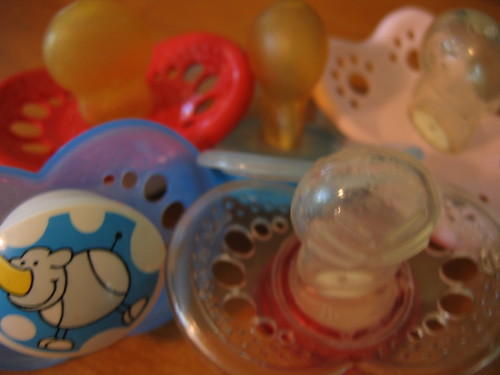
Photo By: djuggler
The pacifier may be one of the greatest innovations known to many parents, because sometimes when all else fails the pacifier, can be what quails the wails of a baby at 2 am!
While there is great debate about the subject of pacifiers we simply wanted to provide you with some basic information.Newborns are born the the innate ability to suck. Some babies have a stronger, yet greater need to suck after an adequate feeding. In addition, to the soothing and calming feeling that comes along with it, so you may find that your baby may take well to a pacifier. However, there are other babies who absolutely refuse the pacifier and prefer their thumb.
Keep in mind that wide range of pacifiers on the market that differ in brands,styles,colors and overall material grade. Once you've decided that you will use a pacifier for your baby you should purchase several types. You wont know which one your baby prefers so its best to keep them on hand so you give them a try. Eventually your baby will let you know if any are the right one.
Benefits:
Soothes fussy infants
Can help reduce the risk of SIDS (Sudden Infant Death Syndrome)
Can be helpful to babies born premature improve their ability to suck
Types of pacifiers
Brand: most common brands are Gerber, Avent, and Sassy Mini Mam are just a few examples of the brands available in most common baby stores or even local drugstores. However, if you want something more unique or specialized such as a personalized pacifier, take a look online for more choices.
Nipple size & shape: many pacifiers are sized according to baby's age (i.e. newborn/stage 1 for babies up to 6 months) so be sure to read the label for proper sizing. The shape of the nipple can vary also as some pacifiers are "orthodontic" which are specially shaped.
Material: many of the pacifier nipples are made of silicone(soft material,flexible)/latex(more sturdy,don't retain odors)/natural rubber, be sure to read packaging to be sure of product details,as some babies are allergic to latex.
Ventilation: be sure that the pacifier of your choice has ventilation holes on each side. Sometimes you may notice a red ring around your baby's mouth that outlines the shape of the pacifier. At times saliva can collect around the sides of the pacifier and eventually irritate your baby's skin.
Hospital Grade: nurseries give standard pacifiers that are considered " hospital grade". These pacifiers are sturdy, durable and safe. So these may be your baby's very first pacifier if you give permission. If your baby does like the "soothie" style of pacifier, be sure to ask for a few extras until you can purchase more. As well, they are available at most stores, so you shouldn't have a problem finding them.
Helpful Tips:
Its important not to "overuse" the pacifier. By that meaning that every time your baby cries or becomes fussy, that this is not the first thing offered. Babies cry and fuss for many reasons. Try to first eliminate other reasons like, hunger, wet diapers or simply not feeling well.
Never use string or any other material to tie a pacifier around your baby's neck, this is very dangerous and can cause strangulation. There are special pacifier clips that simply attach to clothing and the other end can attach to the pacifier itself.
Frequently replace all pacifiers, while inspecting them for for signs of wear holes, odors/fungus (inside the nipple) and detachment from the base.
Finding Unique Baby Pacifiers:
Mumlo: website allows you to create your own personalized pacifier for your baby. You can see how it looks before you buy it. Pacifiers are sold in sets of 4, 8 and 12.
Teethifier: unique teether/pacifier unlike anything you've seen before
Wubbanub: unique cuddly stuffed animals with attached pacifier. 100% adorable
No comments:
Post a Comment